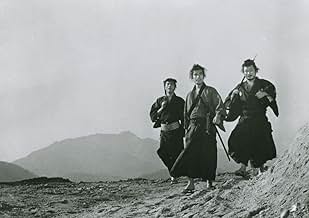De pauvres paysans kidnappent la fille du shogun dans l'espoir d'obtenir une baisse d'impôts. Sensible à leur sort, un ronin errant décide de les aider.De pauvres paysans kidnappent la fille du shogun dans l'espoir d'obtenir une baisse d'impôts. Sensible à leur sort, un ronin errant décide de les aider.De pauvres paysans kidnappent la fille du shogun dans l'espoir d'obtenir une baisse d'impôts. Sensible à leur sort, un ronin errant décide de les aider.
- Réalisation
- Scénario
- Casting principal
Avis à la une
After a title sequence with a bombastic score, the action begins almost immediately in this film. A wandering Samurai stumbles upon a hostage situation - a few pathetic peasants (not too different from the ones in Seven Samurai) are holding the daughter of an aristocrat hostage in the hope that he would waive taxes. After observing the bumbling peasants and their failed negotiations with the aristocracy for a while, the cynical Samurai decides to join the fight on the peasants side.
While watching this film, it struck me that the Samurai attitude towards life is not too different from the cowboys in spaghetti westerns or protagonists in Noir thrillers. They are very cynical and are always watching how the situation unravels. But they often put their neck on the line in the end.
The treatment and portrayal of women in this film is quite hilarious and politically incorrect.
I liked the way the director balanced the different aspects of the film - the film is a mix of cynical tongue in cheek humor and relentless action while also foregrounding themes like samurai honor and the plight of peasants.
The plot, like a Noir film is quite complicated.
(7.5/10)
Of course, there are Gosha's typical studied camera angles and compositions (you see some interesting "moving camera" work, which significantly predates the attempts of "pioneering" US directors). However, "Sanbiki no samurai" also showcases Gosha's ability to tell a story through facial expressions, rather than simply relying upon dialogue.
This is all film-school wankery. The bottom line is that "Sanbiki" is a gripping chambara flick, with a solid morality tale disguised as a cynical amorality tale. (Note that a common theme through many Japanese "chambara" is that of cynical ex-samurai who ultimately decides to risk life and limb for some hopeless but noble "little guy" cause.)
This theme was repeatedly, um, emulated by the likes of Sergio Leone with his spaghetti westerns. However, my point is that such tales are just plain entertaining. The three actors playing the samurai also turn in great performances.
Viewers new to Hideo Gosha may wish to start with "Goyokin" or "Hitokiri" (a/k/a "Tenchu"), but if you've seen those two already (or if they're already checked out), then this is still a definite movie to catch!
As the camerawork goes, you see in these movies where the John Wick films may have gotten some of their inspiration. Longer shots with minimal edits allow the audience to enjoy swordplay between multiple attackers WHILE running. Wide shots of the rural landscape as well as the scenes by the river could be taken as stills for a photography class.
I am a big fan of samurai films. There are many out there that do not feature Toshiro Mifune that are of equal or higher caliber.
This film is one of those. See it the first chance you get!
You may have encountered other examples of this genre and found them underwhelming, but don't dismiss the samurai film altogether before you've seen Hideo Gosha's debut. I guarantee that "Three Outlaw Samurai" will not disappoint.
Le saviez-vous
- AnecdotesHideo Gosha's directorial film debut.
- Citations
Sakon Shiba: [Threatening to kill the Magistrate; his daughter physically intervenes] For his victims' sake, I can't allow him to live.
Aya: Please!
Sakon Shiba: Move, or I'll kill you!
Aya: Kill me, then. No matter what he's done, I'm still his daughter.
Sakon Shiba: [the Magistrate breaks free and runs for it, but Shiba deftly cuts off his top knot with a quick thrust of his sword] Let the lord see you in disgrace. Let the peasants see you in disgrace.
- ConnexionsFeatured in Best in Action: 1964 (2020)
Meilleurs choix
- How long is Three Outlaw Samurai?Alimenté par Alexa
Détails
- Durée
- 1h 34min(94 min)
- Couleur
- Mixage
- Rapport de forme
- 2.35 : 1































